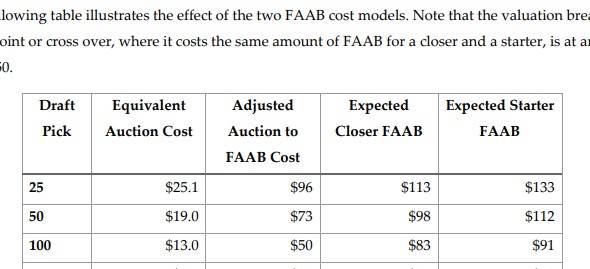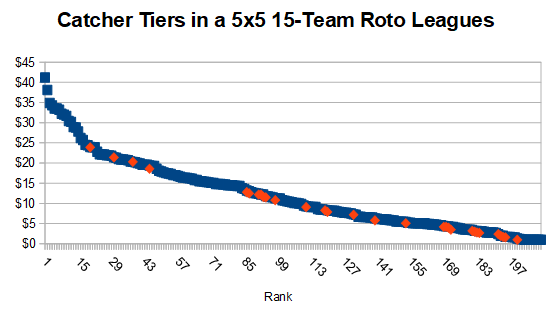Projection Busting Research Updated
Over the years, I’ve been working on how to fine-tune my player evaluation process. The following are six datasets that I’ve found useful I’ll not go into detail on any of them since I provide a link to the original article. The following is basically a referenceable data dump.
Note: I know there is a lot of content and when questions arise, make sure the area in question is obvious in the comment. Also, I’ll only answer questions here and not in the original articles.
Voit/Muncy All-Stars (link)
These are older AAA hitters who have shown signs of a breakout.
| Name | Position | Age | Team | PA | BB% | K% | GB% | ISO |
|---|---|---|---|---|---|---|---|---|
| Adam Engel | OF | 27 | White Sox | 277 | 8% | 22% | 43% | .194 |
| Addison Russell | SS | 25 | Cubs | 119 | 12% | 21% | 38% | .281 |
| Andy Ibanez | 2B/3B | 26 | Rangers | 529 | 10% | 17% | 37% | .197 |
| Austin Dean | OF | 25 | Marlins | 282 | 10% | 18% | 39% | .298 |
| Billy McKinney | OF | 24 | Blue Jays | 154 | 14% | 16% | 35% | .217 |
| Breyvic Valera | 2B | 27 | Yankees | 348 | 10% | 10% | 34% | .200 |
| Bryan Reynolds | OF | 24 | Pirates | 57 | 12% | 19% | 38% | .367 |
| Cavan Biggio | 2B | 24 | Blue Jays | 174 | 20% | 16% | 30% | .203 |
| Chance Sisco | C | 24 | Orioles | 196 | 10% | 22% | 42% | .238 |
| Chas McCormick | OF | 24 | Astros | 225 | 12% | 15% | 37% | .204 |
| Cheslor Cuthbert | 3B | 26 | Royals | 219 | 8% | 21% | 39% | .218 |
| Connor Joe | 1B/3B | 26 | Dodgers | 446 | 16% | 18% | 42% | .203 |
| Cristhian Adames | SS | 27 | Giants | 165 | 12% | 19% | 42% | .234 |
| Daniel Pinero | 3B/SS | 25 | Tigers | 110 | 16% | 23% | 32% | .220 |
| DJ Stewart | OF | 25 | Orioles | 277 | 14% | 18% | 41% | .257 |
| Donnie Dewees | OF | 25 | Cubs | 419 | 10% | 15% | 41% | .207 |
| Esteban Quiroz | 2B/SS | 27 | Padres | 366 | 14% | 22% | 38% | .268 |
| Harrison Bader | OF | 25 | Cardinals | 75 | 11% | 21% | 26% | .381 |
| Jason Vosler | 3B | 25 | Padres | 426 | 11% | 24% | 37% | .232 |
| Jaylin Davis | OF | 24 | Giants | 117 | 12% | 24% | 40% | .353 |
| Jeimer Candelario | 3B | 25 | Tigers | 178 | 12% | 20% | 42% | .268 |
| Johan Camargo | SS | 25 | Braves | 64 | 8% | 19% | 35% | .207 |
| Jonah Heim | C | 24 | Athletics | 119 | 9% | 15% | 34% | .198 |
| Jose Rojas | 3B | 26 | Angels | 578 | 10% | 23% | 31% | .283 |
| Josh VanMeter | 2B/3B | 24 | Reds | 211 | 11% | 18% | 38% | .320 |
| Kevin Cron | 1B | 26 | Diamondbacks | 377 | 16% | 20% | 26% | .446 |
| Mark Payton | OF | 27 | Athletics | 447 | 10% | 17% | 35% | .319 |
| Matt Thaiss | 1B | 24 | Angels | 372 | 16% | 17% | 42% | .203 |
| Michael Brosseau | 3B | 25 | Rays | 315 | 11% | 18% | 40% | .263 |
| Michael Perez | C | 26 | Rays | 216 | 13% | 24% | 36% | .250 |
| Mike Ford | 1B | 26 | Yankees | 349 | 13% | 16% | 40% | .303 |
| Nick Dini | C | 25 | Royals | 213 | 10% | 14% | 33% | .269 |
| Nick Tanielu | 2B/3B | 26 | Astros | 503 | 9% | 17% | 36% | .225 |
| Oscar Mercado | SS/OF | 24 | Indians | 140 | 11% | 23% | 40% | .202 |
| P.J. Higgins | C | 26 | Cubs | 140 | 12% | 21% | 40% | .231 |
| Phillip Ervin | OF | 26 | Reds | 172 | 11% | 20% | 31% | .193 |
| Roberto Pena | C | 27 | Angels | 155 | 11% | 19% | 32% | .196 |
| Ronald Guzman | 1B | 24 | Rangers | 135 | 13% | 23% | 39% | .197 |
| Rowdy Tellez | 1B | 24 | Blue Jays | 109 | 13% | 23% | 34% | .323 |
| Ryan McBroom | 1B | 27 | Yankees | 482 | 12% | 21% | 38% | .259 |
| Ryan O’Hearn | 1B | 25 | Royals | 149 | 11% | 21% | 39% | .302 |
| Taylor Jones | 1B | 25 | Astros | 531 | 13% | 21% | 37% | .210 |
| Taylor Ward | C/3B | 25 | Angels | 512 | 16% | 20% | 38% | .278 |
| Ty France | 1B/3B | 24 | Padres | 348 | 9% | 15% | 31% | .372 |
| Will Smith | C | 24 | Dodgers | 270 | 15% | 18% | 28% | .335 |
| Willie Calhoun | 2B/OF | 24 | Rangers | 172 | 19% | 14% | 33% | .232 |
| Yermin Mercedes | C | 26 | White Sox | 220 | 11% | 19% | 28% | .337 |


